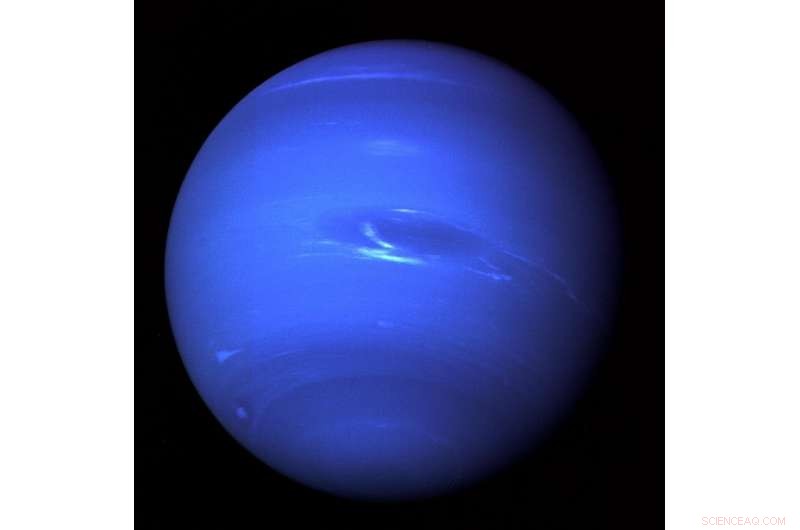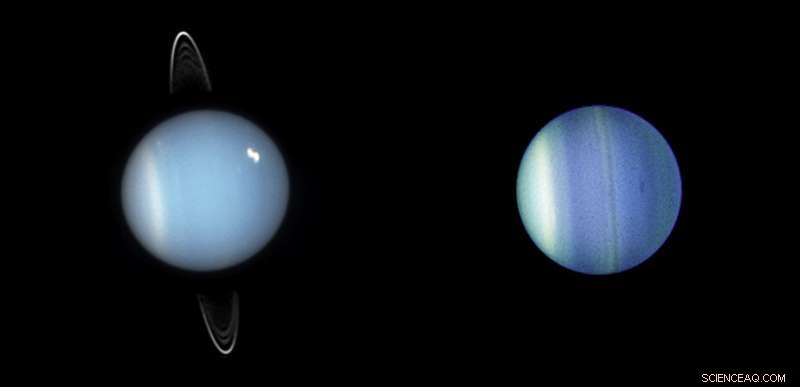
Questa immagine del Voyager 2 di Nettuno mostra un mondo freddo e oscuro sferzato dal vento. Nel 1989, Il Voyager 2 della NASA è diventato il primo e unico veicolo spaziale ad osservare il pianeta Nettuno, passando circa 3, 000 miglia sopra il polo nord del pianeta. Credito:NASA/JPL-Caltech
Urano e Nettuno, i giganti di ghiaccio del nostro sistema solare, sono tanto misteriosi quanto distanti. Subito dopo il suo lancio nel 2021, Il James Webb Space Telescope della NASA cambierà la situazione svelando i segreti delle atmosfere di entrambi i pianeti.
I freddi e remoti pianeti giganti Urano e Nettuno sono soprannominati i "giganti di ghiaccio" perché i loro interni sono compositivamente diversi da Giove e Saturno, che sono più ricchi di idrogeno ed elio, e sono conosciuti come i "giganti gassosi". I giganti del ghiaccio sono anche molto più piccoli dei loro cugini gassosi, essendo di dimensioni intermedie tra i pianeti terrestri e i giganti gassosi. Rappresentano la categoria di pianeti meno esplorata del nostro sistema solare. Gli scienziati che utilizzano Webb pianificano di studiare i modelli di circolazione, chimica e clima di Urano e Nettuno in un modo che solo Webb può fare.
"La cosa fondamentale che Webb può fare è molto, molto difficile da realizzare da qualsiasi altra struttura è mappare la loro temperatura atmosferica e la struttura chimica, " ha spiegato il capo degli studi, Leigh Fletcher, professore associato di scienze planetarie presso l'Università di Leicester nel Regno Unito. "Pensiamo che il tempo e il clima dei giganti di ghiaccio avranno un carattere fondamentalmente diverso rispetto ai giganti gassosi. Ciò è in parte dovuto al fatto che sono così lontani dal Sole, sono di dimensioni più piccole e ruotano più lentamente sui loro assi, ma anche perché la miscela di gas e la quantità di miscelazione atmosferica è molto diversa rispetto a Giove e Saturno".
Tutti i gas nelle alte atmosfere di Urano e Nettuno hanno impronte chimiche uniche che Webb può rilevare. In modo cruciale, Webb può distinguere una sostanza chimica da un'altra. Se queste sostanze chimiche vengono prodotte dalla luce solare che interagisce con l'atmosfera, o se vengono ridistribuiti da un luogo all'altro da modelli di circolazione su larga scala, Webb sarà in grado di vederlo.
Questi studi saranno condotti attraverso un programma di osservazione del tempo garantito (GTO) del sistema solare guidato da Heidi Hammel, uno scienziato planetario e scienziato interdisciplinare Webb. È anche Vice President for Science presso l'Association of Universities for Research in Astronomy (AURA) a Washington, Il programma di D.C. Hammel dimostrerà le capacità di Webb di osservare gli oggetti del sistema solare ed eserciterà alcune delle tecniche specifiche di Webb per oggetti luminosi e/o in movimento nel cielo.
Urano:il pianeta inclinato
A differenza degli altri pianeti del nostro sistema solare, Urano, insieme ai suoi anelli e alle sue lune, è inclinato su un fianco, ruotando di circa un angolo di 90 gradi dal piano della sua orbita. Questo fa sembrare il pianeta rotolare come una palla attorno al Sole. Questo strano orientamento, che potrebbe essere il risultato di una gigantesca collisione con un altro enorme protopianeta all'inizio della formazione del sistema solare, dà origine a stagioni estreme su Urano.
Quando la navicella spaziale Voyager 2 della NASA volò vicino a Urano nel 1986, un polo puntava direttamente al sole. "Non importa quanto Urano girerebbe, "Hammel ha spiegato, "una metà era sempre in piena luce del sole, e l'altra metà era nell'oscurità totale. It's the craziest thing you can imagine."
Disappointingly, Voyager 2 saw only a billiard-ball smooth planet covered in haze, with only a scant handful of clouds. But when Hubble viewed Uranus in the early 2000s, the planet had traveled a quarter of the way around in its orbit. Now the equator was pointed at the Sun, and the entire planet was illuminated over the course of a Uranian day.
"Theory told us nothing would change, " said Hammel, "But the reality was that Uranus started sprouting up all kinds of bright clouds, and a dark spot was discovered by Hubble. The clouds seemed to be changing dramatically in response to the immediate change in sunlight as the planet traveled around the Sun."

These Hubble Space Telescope images show the varied faces of Uranus. On the left, Uranus in 2005 displays its ring system. The planet -- along with its rings and moons -- is tipped on its side, rotating at roughly a 90-degree angle from the plane of its orbit. In the Hubble close-up taken just one year later, Uranus reveals its banded structure and a mysterious dark storm. Credito:NASA, ESA, and M. Showalter (SETI Institute); Right:NASA, ESA, L. Sromovsky and P. Fry (U. Wisconsin), H. Hammel (Space Science Institute), and K. Rages (SETI Institute)
As the planet continues its slow orbital trek, it will point its other pole at the Sun in 2028.
Webb will give insight into the powerful seasonal forces driving the formation of its clouds and weather, and how this is changing with time. It will help determine how energy flows and is transported through the Uranian atmosphere. Scientists want to watch Uranus throughout Webb's life, to build up a timeline of how the atmosphere responds to the extreme seasons. That will help them understand why this planet's atmosphere seems to go through periods of intense activity punctuated by moments of calm.
Neptune:A World of Supersonic Winds
Neptune is a dark, cold world, yet it is whipped by supersonic winds that can reach up 1, 500 miles per hour. More than 30 times as far from the Sun as Earth, Neptune is the only planet in our solar system not visible to the naked eye. Its existence was predicted by mathematics before its discovery in 1846. In 2011, Neptune completed its first 165-year orbit since its discovery.
Like Uranus, this ice giant's very deep atmosphere is made of a thick soup of water, ammoniaca, hydrogen sulfide and methane over an unknown and inaccessible interior. The accessible upper layers of the atmosphere are made of hydrogen, helium and methane. As with Uranus, the methane gives Neptune its blue color, but some still-mysterious atmospheric chemistry makes Neptune's blue a bit more striking than that of Uranus.
"It's the same question here:How does energy flow and how is it transported through a planetary atmosphere?" explained Fletcher. "But in this case, unlike Uranus, the planet has a strong internal heat source. That heat source generates some of the most powerful winds and the most short-lived atmospheric vortices and cloud features of anywhere in the solar system. If we look at Neptune from night to night, its face is always shifting and changing as these clouds are stretched and pulled and manipulated by the underlying wind field."
Following the 1989 Voyager 2 flyby of Neptune, scientists discovered a bright, hot vortex—a storm—at the planet's south pole. Because the temperature there is higher than everywhere else in the atmosphere, this region is likely associated with some unique chemistry. Webb's sensitivity will allow scientists to understand the unusual chemical environment within that polar vortex.
Just the Beginning
Fletcher advises to be prepared for seeing phenomena on Uranus and Neptune that are totally unlike what we've witnessed in the past. "Webb really has the capability to see the ice giants in a whole new light. But to understand the continual atmospheric processes that are shaping these giant planets, you really need more than just a couple of samples, " he said. "So we compare Jupiter to Saturn to Uranus to Neptune, and by that, we build up a wider picture of how atmospheres work in general. This is the beginning of understanding how these worlds are changing with time."
Hammel added, "We now know of hundreds of exoplanets—planets around other stars—of the size of our local ice giants. Uranus and Neptune provide us ground truth for studies of these newly discovered worlds."
The James Webb Space Telescope will be the world's premier space science observatory when it launches in 2021. Webb will solve mysteries in our solar system, guarda oltre a mondi lontani intorno ad altre stelle, e sondare le misteriose strutture e origini del nostro universo e il nostro posto in esso. Webb is an international program led by NASA with its partners, ESA (Agenzia Spaziale Europea) e Agenzia Spaziale Canadese.